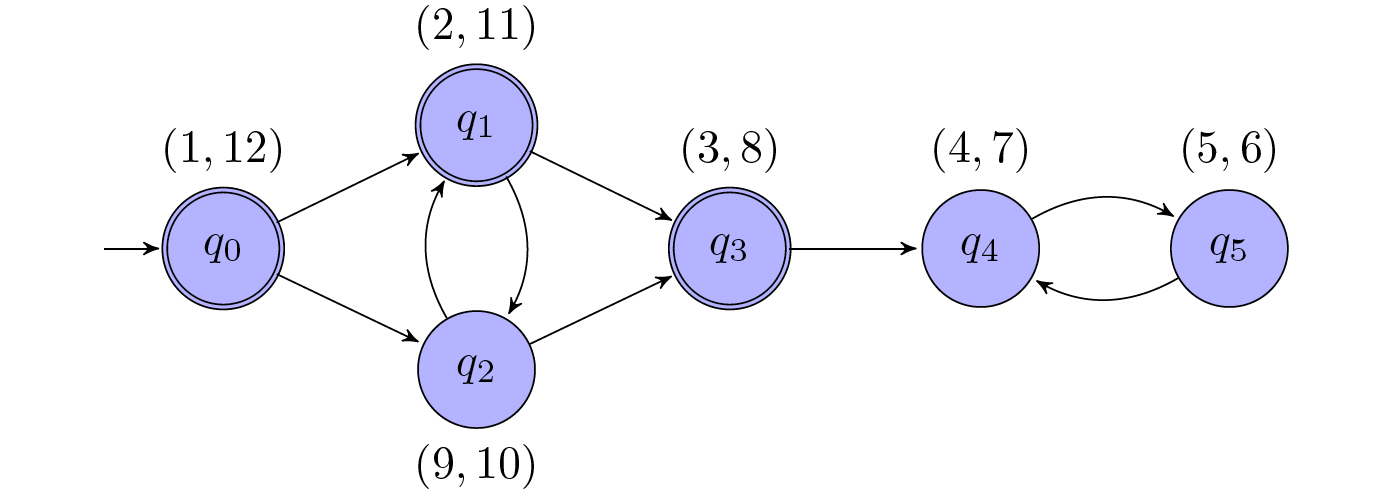Previous chapter: Automata-based LTL Model Checking with Sequential Circuits
This is a learning note of a course in CISPA, UdS. Taught by Bernd Finkbeiner
Introduction
We now develop an algorithm for checking whether the language of a given Büchi automaton is empty. A natural idea is to use depth-first search (DFS) twice.
The language is non-empty $\Leftrightarrow$ it is accepted by some words:
- there exists an accepting state $q$,
- $q$ is reachable from some initial state (discovered by 1st DFS), and
- $q$ can again be reached from $q$ (discovered by 2nd DFS),
Example (Simple DFS)
Consider the following Büchi automaton (edge labels do not matter and are omitted).

Step 1: discovers $q_0$, $q_1$, and $q_3$.Step 2: searches from $q_0$ and $q_3$: not successful; searches from $q_1$: discovers the path back to $q_1$ via $q_2$.
The drawback of the algorithm discussed so far is its quadratic running time: potentially, each state in $F$ discovered by the first DFS requires a fresh second DFS. The quadratic running time can be avoided by stopping the DFS in Step 2 whenever a state is encountered that was already visited during Step 2.
However, this is only sound if the searches in Step 2 are executed in the right order. If we first execute the DFS from $q_0$ in Example 9.2, then this search visits all states; in a subsequent search from $q_1$, we would, therefore, no longer discover the successful path back to $q_1$ via $q_2$!
It turns out that it is sound to restrict the searches in Step 2 if they are executed in order of increasing finishing times of the DFS in Step 1. The emptiness check with nested DFS therefore uses Step 1 to order the reachable accepting states according to their finishing times; in Step 2, a DFS is initiated from each reachable accepting state in this order until a cycle is detected. Step 2 marks the visited states and restricts the searches so that no state is visited twice during Step 2.
A Modified Example (Nested DFS)
Continue from above, a possible annotation of the states with pairs (discovery, finishing) of discovery and finishing times during the DFS in Step 1 is the following:

Ordering the accepting states according to increasing finishing times, we obtain the order $q_3$, $q_1$, $q_0$. In Step 2, the DFS from $q_3$ visits (unsuccessfully) $q_3$, $q_4$ and $q_5$. The DFS from $q_1$
then only visits $q_1$ and $q_2$, upon which it has successfully discovered the path from $q_2$ to $q_2$.
Nested DFS and Büchi Automaton
$\textbf{Theorem 9.1. }\textit{For a Büchi automaton }\mathcal{A}\textit{, nested DFS is successful iff }\mathcal{L(A)}\textit{ is nonempty.}$
Proof
$”\Rightarrow”$
If the nested DFS is successful then there exists a state $q$ that is reachable from some initial state such that there is a path from $q$ back to $q$. Hence, $\mathcal{L(A)}$ is non-empty.
$”\Leftarrow”$
To show that we can safely ignore the states that were visited in previous searches in Step 2, we consider the situation at the beginning of a DFS from some accepting state $q\in F$ in Step 2. Let $T$ be the set of states visited in previous searches in Step 2. We prove that there is no cycle $q_0,q_1,\dots,q_k$ with $q=q_0=q_k$ such that $\lbrace q_0,q_1,\dots,q_k\rbrace\cap T\neq \varnothing$ i.e., the states in $T$ can be ignored while looking for $q$-cycles.
Assume, by way of contradiction, that there is a state $q$ where this condition is violated for the first time. Let $t\in\lbrace q_0,q_1,\dots,q_k\rbrace\cap T$, and let $u\in F$ be the accepting state such that $t$ has been added to $T$ during the DFS in Step 2. This means that the DFS from $u$ was invoked before the DFS from $q$; hence, $u$ has an earlier finishing time than $q$ in den DFS of Step 1.
Case 1: $u$ was discovered before $q$ in the DFS of
Step 1. This cannot be the case, because $q$ is reachable from $u$, and, thus, the finishing time of $q$ would have been earlier than that of $u$.Case 2: u was discovered after $q$ in the DFS of
Step 1. Then $q$ was still on the stack of the DFS when $u$ was finished. Hence, $u$ is reachable from $q$. Thus, $u$ and $q$ are on a cycle. This cycle (or some other cycle) would have been discovered during the DFS from $u$ inStep 2.
Next chapter: The Emerson-Lei algorithm
Please cite the source for reprints, feel free to verify the sources cited in the article, and point out any errors or lack of clarity of expression. You can comment in the comments section below or email to GreenMeeple@yahoo.com